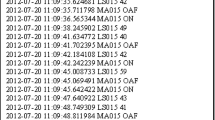Abstract
With the increasing demands of the remote surveillance system, the gait based personal identification research has obtained more and more attention from biometric recognition researchers. The gait sequence is easier to be affected by factors than other biometric feathers. In order to achieve better performance of the gait based identification system, in the paper, a local discriminant gait recognition method is proposed by integrating weighted adaptive center symmetric local binary pattern (WACS-LBP) with local linear discriminate projection (LLDP). The proposed method consists of two stages. In the first stage, the robust local weighted histogram feature vector is extracted from each gait image by WACS-LBP. In the second stage, the dimensionality of the extracted feature vector is reduced by LLDP. The highlights of the proposed method are (1) the extracted feature is robust to rotation invariant, and is also tolerant to illumination and pose changes; (2) the low dimensional feature vector reduced by LLDP can preserve the discriminating ability; and (3) the small-sample-size (SSS) problem is avoided naturally. The proposed method is validated and compared with the existing algorithms on a public gait database. The experimental results show that the proposed method is not only effective, but also can be clearly interpreted.








Similar content being viewed by others
References
Ahonen T, Hadid A, Pietikäinen M (2006) Face description with local binary patterns: application to face recognition. IEEE Trans Pattern Anal Mach Intell 28(12):2037–2041
Castro FM, Marín-Jiménez MJ, Guil N (2016) Multimodal features fusion for gait, gender and shoes recognition. Mach Vis Appl:1–16
Deng M, Wang C, Cheng F et al (2017) Fusion of spatial-temporal and kinematic features for gait recognition with deterministic learning. Pattern Recogn 67:186–200
Emdad Hossain SM, Chetty G (2015) Multimodal biometric database for person identification and gait analysis. Intern J Intell Info Process 5(3):1–10
Fan Z, Xu Y, Zhang D (2011) Local linear discriminant analysis framework using sample neighbors. IEEE Trans Neural Netw 22(7):1119–1132
Fan Z, Xu Y, Ni M et al (2016) Individualized learning for improving kernel Fisher discriminant analysis. Pattern Recogn 58(C):100–109
Johannson G (1973) Visual perception of biological motion and a model for its analysis. Percept Psychophys 14:201–211
Kim SM, Lee DJ, Chun MG (2014) Infrared gait recognition using wavelet transform and linear discriminant analysis. J Korean Institute Intelligent Sys 24(6):622–627
Lai Z, Xu Y, Jin Z et al (2014) Human gait recognition via sparse discriminant projection learning. IEEE Trans Circuits Syst Video Technol 24(10):1651–1662
Liu X, Wang H, Wang J et al (2017) Person re-identification by multiple instance metric learning with impostor rejection. Pattern Recogn 67:287–298
Lu J, Wang G, Moulin P (2014) Human identity and gender recognition from gait sequences with arbitrary walking directions. Info Forensics Sec IEEE Trans on 9(1):51–61
Luo J, Zhang J, Zi C et al (2015) Gait recognition using GEI and AFDEI. Int J Optics 2015(5):1–5
H P Mohan Kumar, H S Nagendraswamy (2014) LBP for gait recognition: A symbolic approach based on GEI plus RBL of GEI. International Conference on Electronics and Communication Systems, 1–5.
Mohan Kumar HP, Nagendraswamy HS (2014) Symbolic representation and recognition of gait: an approach based on LBP of split gait energy images. Signal Image Process: An Int J (SIPIJ) 5(4):15–28
Ojala T, Pietikäinen M, Mäenpää T (2002) Multiresolution gray-scale and rotation invariant texture classification with local binary patterns. IEEE Trans. Patt Anal Machine Intell 24(7):971–987
Pepler PT, Uys DW, Nel DG (2016) Discriminant analysis under the common principal components model. Communications Statistics: Simulation Compt. doi:10.1080/03610918.2015.1134568
Shi Y, Wang XQ, Zhang YC (2015) A recognition method of gait by wavelet transform and genetic algorithm. Appl Mech Mater 701-702:274–278
Sithi Shameem Fathima SMH, Wahida Banu RSD (2015) Human Gait Recognition Using Silhouettes. Int J Appl Eng Res 10:5443–5454
Tafazzoli F, Bebis G, Louis S et al (2015) Genetic feature selection for gait recognition. J Electron Imaging 24(1):013036 -1-14
Xing X, Wang K, Lv Z (2015) Fusion of gait and facial features using coupled projections for people identification at a distance. IEEE Signal Process Lett 22(12):2349–2353
Xu Y, Yang J-y, Lu J et al (2004) An efficient renovation on kernel Fisher discriminant analysis and face recognition experiments. Pattern Recogn 37(10):2091–2094
Xue Z, Dong M, Song W et al (2010) Infrared gait recognition based on wavelet transforms and support vector machine. Pattern Recogn 43(8):2904–2910
Yang M (2010) Dacheng Tao. Biologically inspired feature manifold for gait recognition Neurocomputing 73:895–902
Zhang S, Zhang C (2015) Orthogonal margin maximization projection for gait recognition. Informatica 26(2):357–367
Zhao G, Pietikainen M (2007) Dynamic texture recognition using local binary patterns with an application to facial expressions. IEEE Trans Pattern Anal Mach Intell 29(6):915–928
Zhao Y, Zhang D, Du M (2016) A novel supervised feature extraction algorithm: enhanced within-class linear discriminant analysis. Int J Comput Sci Eng 13(1):13–23
Zheng S, Huang K, Tan T et al (2012) A cascade fusion scheme for gait and cumulative foot pressure image recognition. Pattern Recogn 45(10):3603–3610
Acknowledgments
This work is supported by the China National Natural Science Foundation under grant Nos. 61473237. It is also supported by the Shaanxi Natural Science Foundation Research Project under grant No. 2014JM2-6096, Tianjin Research Program of Application Foundation and Advanced Technology No. 14JCYBJC42500 and Tianjin science and technology correspondent project No. 16JCTPJC47300. The authors would like to thank the gait CASIA subset and all the editors and anonymous reviewers for their constructive advices.
Author information
Authors and Affiliations
Corresponding author
Rights and permissions
About this article
Cite this article
Zhang, S., Zhang, L. Combining weighted adaptive CS-LBP and local linear discriminant projection for gait recognition. Multimed Tools Appl 77, 12331–12347 (2018). https://doi.org/10.1007/s11042-017-4884-6
Received:
Revised:
Accepted:
Published:
Issue Date:
DOI: https://doi.org/10.1007/s11042-017-4884-6




